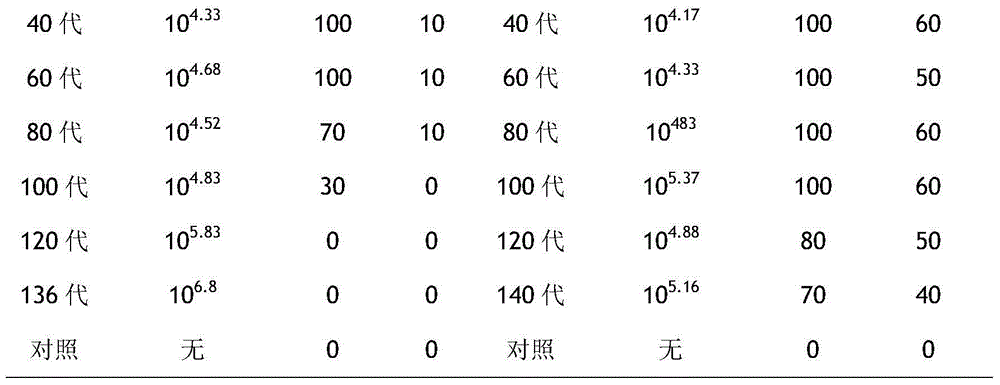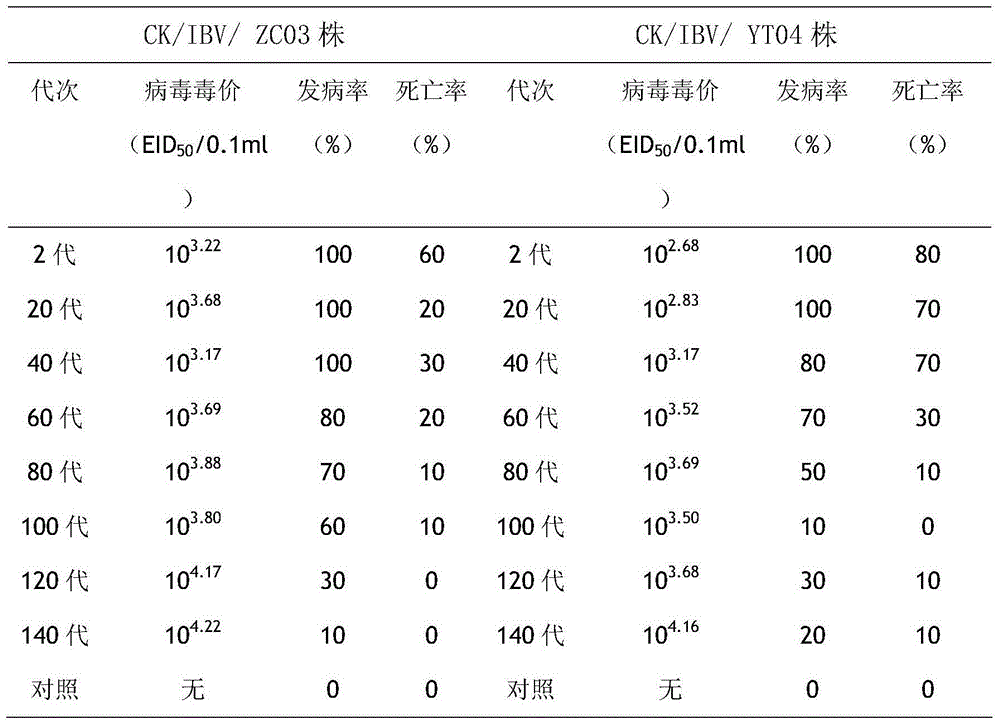Chicken infectious bronchitis divalent live vaccine and preparation method thereof
A bronchitis and chicken infectious technology, applied in the field of chicken infectious bronchitis bivalent live vaccine and its preparation, can solve the problem of no prevention and achieve the effect of reducing immune stress
- Summary
- Abstract
- Description
- Claims
- Application Information
AI Technical Summary
Problems solved by technology
Method used
Image
Examples
Embodiment 1
[0025] Example 1: Screening of Chicken Infectious Bronchitis Kidney Type K136 Strain
[0026] From 2003 to 2005, our company collected suspected chicken infectious bronchitis virus isolates from different chicken farms in my country. The sick chickens mainly manifested as lack of energy, coughing, and often heard grunting. Pathological autopsy found that there were obvious lesions in the kidneys in addition to small bleeding spots in the tracheal ring. After preliminary identification, 4 strains of renal-type infectious bronchitis virus were obtained. They were named CK / IBV / QD03 strain, CK / IBV / ZC03 strain, CK / IBV / YT04 strain and CK / IBV / SD05 strain respectively. Use 10-day-old SPF chicken embryos to carry out continuous subculture to attenuate the four strains. In each generation, 4 chicken embryos were inoculated through the allantoic cavity, incubated at 37°C, and the chicken embryos were frozen to death 36 hours after inoculation, and the allantoic fluid was harvested for th...
Embodiment 2
[0035] Embodiment 2: K136 strain safety detection
[0036] 1. Determination of toxicity of K136 strains of different generations on chicken embryos
[0037] Take the E2, E4, E7, E10, E15 generation virus seeds of the K136 strain, make appropriate multiple dilutions, inoculate 10-day-old SPF chicken embryos through the allantoic cavity, 0.1 mL per embryo, and set a blank control group at the same time, The cavity was inoculated with 0.1 mL of physiological saline, and incubated at 37°C. The chicken embryos that died within 24 hours were discarded, and after 144 hours of incubation, the embryos were taken out to observe the development of the chicken embryos. Calculation of EID according to the Reed-Muench method 50 , the poisonous price of E2, E4, E7, E10, E15 generation poison species is respectively: 10 6.7 、10 6.8 、10 6.5 、10 6.6 、10 6.8 EID 50 / 0.1mL. The test results showed that the K136 strain proliferated stably on chicken embryos, and there was no reversion of ...
Embodiment 3
[0044] Example 3: Evaluation of immune efficacy of different generations of K136 strain
[0045] Use the E2, E4, E7, E10, E15 generation K136 strains to breed chicken embryo allantoic fluid in 5×10 2.0 EID 50 Dosage, intranasal drops for 1-day-old SPF chickens, 14 days after immunization, together with control chickens, each chicken used 10 3.68 EID 50 / 0.1mL of the isolated virulent CK / IBV / SD05 strain 0.05mL for eye drops and nasal drops respectively. On the 5th day after the challenge, the tracheal swabs of each chicken were collected and inoculated into the 10-day-old SPF chicken embryo 5 through the allantoic cavity. Embryo, 0.1mL / embryo, incubated for 144 hours. The results showed that the toxicity rate of the immune group was between 0 / 10-1 / 10, and the protection rate was between 9 / 10-10 / 10; the toxicity rate of the control group was 10 / 10. It shows that the immunogenicity of IBV-K136 strain virus seeds is basically the same within 15 generations, and they all have g...
PUM
 Login to View More
Login to View More Abstract
Description
Claims
Application Information
 Login to View More
Login to View More - R&D
- Intellectual Property
- Life Sciences
- Materials
- Tech Scout
- Unparalleled Data Quality
- Higher Quality Content
- 60% Fewer Hallucinations
Browse by: Latest US Patents, China's latest patents, Technical Efficacy Thesaurus, Application Domain, Technology Topic, Popular Technical Reports.
© 2025 PatSnap. All rights reserved.Legal|Privacy policy|Modern Slavery Act Transparency Statement|Sitemap|About US| Contact US: help@patsnap.com



